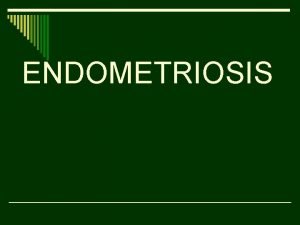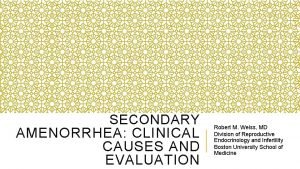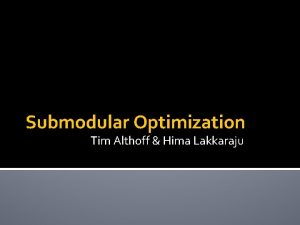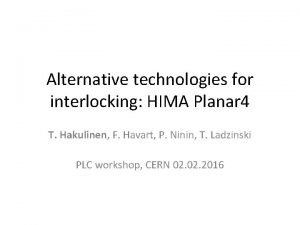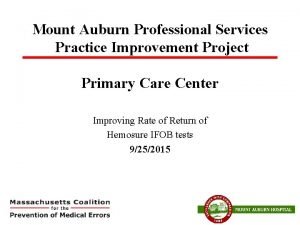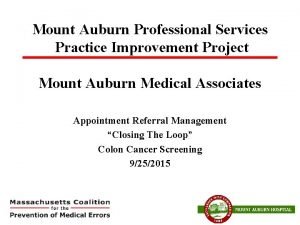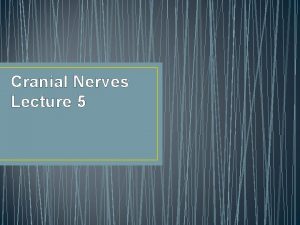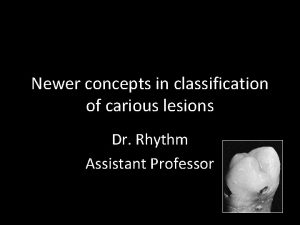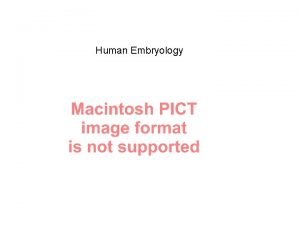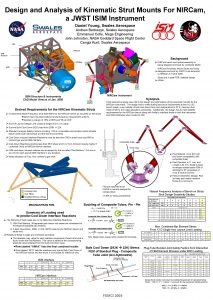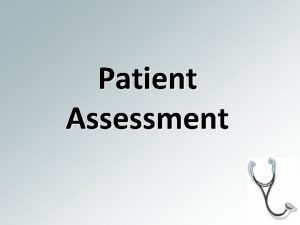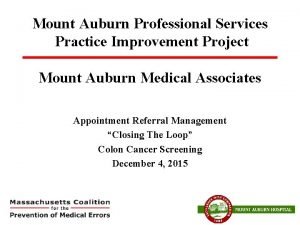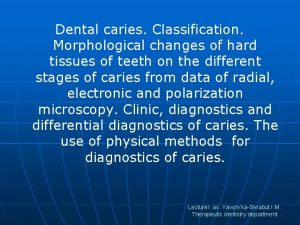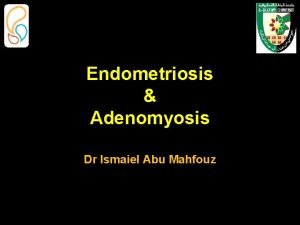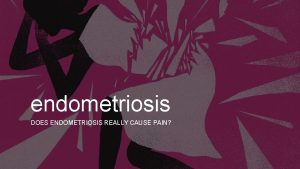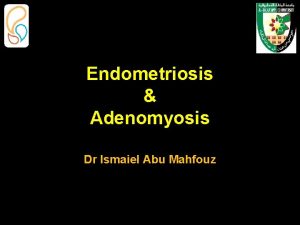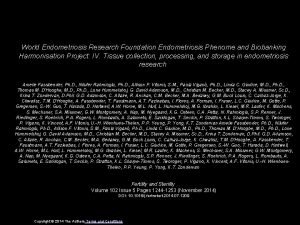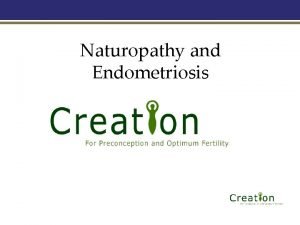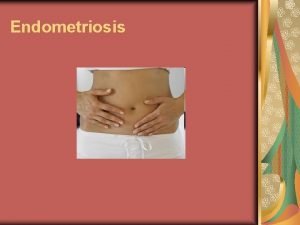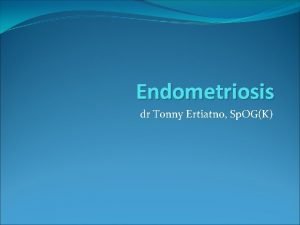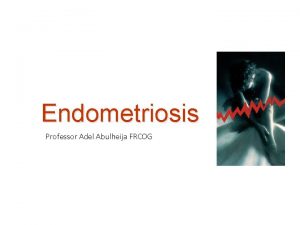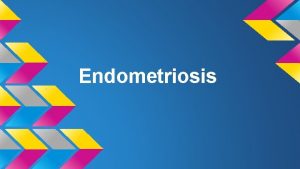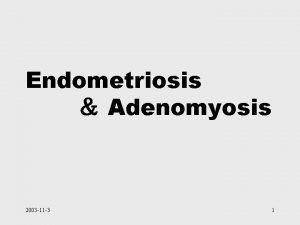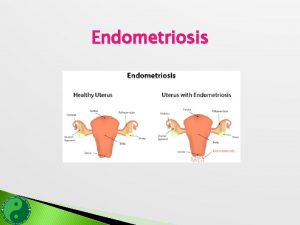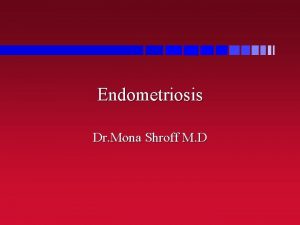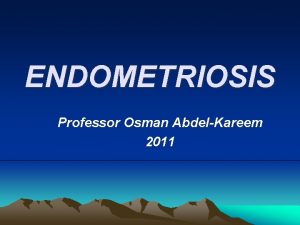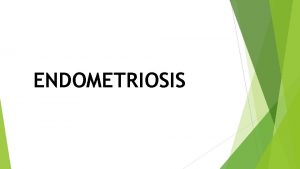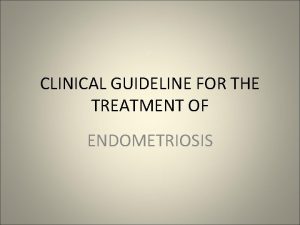Endometriosis Dr Hima Kandimalla Mount Hope Womens Hospital































































- Slides: 63

Endometriosis Dr. Hima Kandimalla Mount Hope Women’s Hospital Trinidad & Tobago

Endometriosis Presence of endometrial glands & stroma outside the endometrial cavity and uterine musculature

Endometriosis Epidemiology • Globally 90 million suffering with Endometriosis • Prevalence: 3 -10% of reproductive age group & 25 -35% of infertile women • Peak incidence: 30 -45 yrs of age • Prevalence is similar in all races

Endometriosis sites

Endometriosis Pathogenesis Implantation or Metastatic theory - Sampson, 1927 Retrograde menstruation • • More common in young girls with genital outflow obstruction Physiological phenomenon – Halme et al, AJOG, 1984

Endometriosis • Retrograde menstruation ? Contributing factors 1. Alteration in the Endometrium 2. Altered Immune response 3. Favorable Peritoneal environment • Mechanical – Endometriotic foci in surgical scars • Lymphatic or Hematogenous – Extragenital locations

Endometriosis Metaplasia theory – Meyer, 1919 Metaplastic changes in coelomic membrane towards endometrial like tissue following prolonged irritation or Oestrogen stimulation

Endometriosis Genetic, Immunological & environmental factors • 7 times more common in 1°relatives – Halme et al, 1986 & Sampson et al 1980 • More common in Monozygotic twins than in Dizygotic twins – Simpson et al, 1984 • Decreased cellular immunity to endometriotic tissue - Dmowski et al, 1981 • ? Dioxins – Endometriosis association, 1993

Endometriosis Mechanical Endocrine Immunological Implantation Genetic Metaplasia Endometrial implant Progression & invasion Lymphatic & Blood spread Adapted & Modified from – R. W. Shaw, Gynecology

Endometriosis Pathology • Puckered black lesions • White scarring • Red polyps • Clear blebs

White plaques & Clear vesicles Blue-black lesions Newly formed blood vessels


Endometriosis Pathology Endometrioma • Contains blood, fluid & menstrual debris • Brown to black color due to Hemosiderin

Endometriosis Pathology Microscopy • Endometrial glands & stroma • Often contain fibrous tissue, blood & cysts

Endometriosis Stromal endometriosis • Implants contain only stromal component without glandular part • Not hormonal dependent • Locally malignant

Endometriosis Staging – American society of Reproductive Medicine, 1996 Stage I – Minimal Isolated superficial implants, No adhesions Stage II – Mild More superficial implants (<5 cm), No significant adhesions

Endometriosis Staging – American society of Reproductive Medicine, 1996 Stage III – Moderate Multiple superficial & invasive implants, Peritubal & Periovarian adhesions may be present Stage IV – Severe Multiple implants, Ovarian endometriomas, Many dense adhesions

Endometriosis Staging – American society of Reproductive Medicine, 1996 • Staging is designed to predict the likelihood of future fertility • There is no correlation between the stage of disease & the degree of pain or the prognosis with treatment

Endometriosis Diagnosis • Often misdiagnosed • The average time to diagnosis is 9. 28 years – Endometriosis association study, 1998 • Delay in diagnosis: - Progression of symptoms - Infertility till complete reproductive failure

Endometriosis Symptoms Reproductive organs • Dysmenorrhoea • Lower abdominal, pelvic & low back pain • Menstrual irregularities • Infertility

Endometriosis Symptoms GIT • • Cyclical rectal bleeding Tenesmus Dyschesia Diarrhea/ Cyclic constipation • Image courtesy of Dr. Andrew Cook. Visit his site: Endometriosis

Endometriosis Symptoms Urinary tract • Cyclical hematuria • Cyclical dysuria • Ureteric obstruction

Endometriosis Symptoms Lungs • Cyclical hemoptysis • Blood stained Pleural effusions • Catamenial Pneumothorax Haemothorax & ascites associated with endometriosis. - Charran D, Roopnarinesingh S. Department of Obstetrics and Gynaecology, U. W. I. , Trinidad. West Indian Med J. 1993 Mar; 42(1): 40 -1.

Endometriosis Symptoms Umbilicus & Surgical scars • Cyclical pain & swelling

Endometriosis Symptoms • Dysmenorrhoea • Pelvic pain • Infertility • Dyspareunia • Menstrual irregularities • Cyclical dysuria / hematuria • Dyschesia • Cyclic Rectal bleeding 60 -80% 30 -50% 30 -40% 25 -40% 10 -20% 1 -2% <1%

Endometriosis Signs • Pelvic tenderness. • Fixed retroverted uterus. • Nodularity of the Douglas pouch and uterosacral ligaments. • Ovaries may be enlarged and tender. Ovarian cyst may be detected.

Endometriosis Infertility • Clear association with infertility has not been established • Incidence of endometriosis in general population of reproductive age : 2 -10% - Barbieri et al, 1990 • Incidence of endometriosis in infertile women: 20 -40% - Mahmood et al, 1990

Endometriosis Infertility In early stages: • • Activated macrophages in peritoneal fluid PG, IL-1, TNF & proteases in peritoneal fluid levels of anti-endometrial antibodies Luteal phase dysfunction Abnormal follicle growth Multiple premature LH surges LUF syndrome

Endometriosis Infertility In advanced stages: • Pelvic adhesions impairs ova release, blocks sperm entry into the peritoneal cavity & inhibits tubal pickup of the oocyte

Endometriosis Risk of cancer • Ovarian Clear cell & Endometrial cell carcinomas • Breast cancer, Melanoma & NHL - Endometriosis Association study, 1998

Endometriosis Differential diagnosis • Pelvic infection • Uterine Myomas • Ovarian malignant tumors with metastatic deposits in the pouch of Douglas • Acute abdomen • Rectal carcinoma

Endometriosis Investigations Laparoscopy ‘Gold standard’ diagnostic test for endometriosis It permits a “see & treat” approach, although its effectiveness may be limited by the nature of the disease and the surgeon's skill


Endometriosis Investigations Serum CA 125 I 19 II 40 III 77 IV 182 - Cheg YM et al, Obst Gyn, 2002 • Sensitivity 28% & specificity 90% - Mol BW et al, Fertil Steril, 1998 • Not useful for screening, because of poor sensitivity • Can be used to identify a sub-group of women who are likely to benefit from early laparoscopy & to follow the progress of disease after establishing the diagnosis

Endometriosis Investigations Ultrasound Sensitivity for focal endometrial implants is poor

Endometriosis Investigations Ultrasound For Endometriomas sensitivity 83% & specificity 98%

Endometriosis Investigations CT scan • Endometriomas may appear solid, cystic or mixed • Because of poor specificity & high radiation, CT has been replaced by MRI

Endometriosis Investigations MRI • Role is limited in visualizing small endometriotic implants and adhesions • More useful for lesions in extraperitoneal locations & the contents of pelvic mass • More frequently used in staging & treatment response monitoring

Endometriosis Treatment Consider • Age • Symptoms • Stage • Infertility

Endometriosis Treatment Rationale • Recognize Goals: – – Pain Management Preservation / Restoration of Fertility • Discuss with Patient: – – Disease may be Chronic and Not Curable Optimal Treatment Unproven or Nonexistent

Endometriosis Lines of management • • Expectant Medical Hormonal Surgical

Endometriosis Expectant management • Young , asymptomatic infertile patient with mild endometriosis. • If pregnancy does not achieved within 12 - 18 months of observation, hormonal or surgical treatment is indicated.

Endometriosis Medical Treatment Symptomatic pts with minimal or mild lesions • • NSAIDs Opioids.

Endometriosis Hormonal Treatment Produces pseudo pregnancy or pseudo menopause • • • Danazol Progestins Gestrinone Combined oestrogen-progestogen Pills Gn. RH agonists.

Endometriosis Hormonal Treatment Indications • • • Small & superficial lesions Recurrence after conservative surgery Preoperative for 6 -12 wks to decrease size Postoperative for residual lesions When surgery is contraindicated or refused by the patient. Enometriosis in Rectovaginal septum & laparotomy scars doesn’t respond to Hormonal therapy

Endometriosis Danazol • Isoxazole derivative of 17 – alpha ethinyl testosterone • Causes anovulation by • Attenuating the mid cycle surge of LH • Inhibiting multiple enzymes in steroidogenic pathway • Testosterone levels • Dose: 400 – 800 mg/ day for 6 months • Adverse effects: Androgenic effects, effects on serum lipids, Bone mineral density & Liver damage

Endometriosis Progestational drugs • Causes endometrial decidualization & atrophy • Medroxyprogesterone (Provera) is commonly used • Dose: 20 -30 mg/ day for 6 -9 months • Adverse effects: Abnormal uterine bleeding, nausea, breast tenderness, fluid retention & depression

Endometriosis Gestrinone (Ethylnorgestrienone) • Antiprogestational steroid causes estrogen & progesterone receptors • Dose: 5 -10 mg/ wk - dly or twice a wk or 3 times a wk, for 6 -9 months • Adverse effects: deepening of voice, hirsuitism & Clitorial hypertrophy

Endometriosis Combined pills • Well tolerated & can be continued for long term • 1 pill/ day either continuously or cyclically • Continuous regimen is superior in patients with dysmenorrhea • Adverse effects: weight gain, abnormal bleeding & HTN

Endometriosis Gn. RH agonists • FSH & LH & results in endometrial atrophy & amenorrhea • Intranasally or SC or IM with a frequency of twice dly to once in 3 months up to 3 - 6 months • Adverse effects: transient vaginal bleeding, hot flushes, vaginal dryness, libido, breast tenderness, insomnia, depression, irritability, fatigue, headache, osteoporosis, elasticity of skin • Gn. RH agonists + Add-back therapy (estrogens & progestogen) – less side-effects but with same efficacy, can be continued beyond 6 months

Endometriosis Hormonal Treatment The choice between the COCPs, Progestogens, Danazol & Gn. RH agonists depends principally upon their side-effect profiles because they relieve pain associated with endometriosis equally well - Clinical Green Top Guidelines, 2000

Endometriosis Surgical management • Conservative – Excision, Cauterization & Evaporation • Surgeries for pain - Uterosacral Nerve Ablation (LUNA), Presacral Neurectomy • Radical surgeries - Hysterectomy +/- BSO • Surgeries for Endometrioma – Cystectomy, Drainage & coagulation, Fenestration

Endometriosis Surgical management Laparotomy Vs Laparoscopy • • Efficacy is same Laparoscopy – less cost & shorter recovery time even in women with advanced endometriosis

Endometriosis Laparoscopic management 1. 2. 3. 4. 5. 6. Excision Vaporization Fulguration & Desiccation Cystectomy for endomterioma Drainage & Coagulation for endometrioma Fenestration for endometrioma • No RCTs available to compare these procedures • Cystectomy offer better results than drainage & coagulation for Endometrioma • If no cyst wall is present, Fenestration followed by Gn. RH agonists may prove beneficial

Endometriosis Laparoscopic management

Surgical management outcome was poorest in minimal endometriosis • much better in moderate & severe cases • - Sutton CJ et al, Fertil Steril 1994

Endometriosis Combination of Hormonal & Surgical • Postoperative Danazol & Medroxyprogesterone for 6 months lowered the pain scores significantly – Telimaa S et al, Gynecol Endo, 1987 • Postoperative Gn. RH agonist for 6 months lowered the recurrence rates but with no change in pain scores – Parazzini F et al, AJOG, 1994 • Sufficient data is not available to conclude that hormonal & surgical combination is associated with significant benefits. The possible benefits should be weighed in the context of the adverse effects & costs of these therapies - Cochrane review, May 2004

Endometriosis Infertility Management • No role for medical therapy with hormonal drugs • Laparoscopic ablation of minimal – mild endometriosis may improve fertility rates - Cochrane review, 2004

Endometriosis IUI • The presence of endometriosis does not generally impair the results of IUI • Ovarian hyperstimulation using Gonadotrophins with IUI is better than no treatment or IUI alone - Nulsen Jc et al, Obst Gyn, 1993 & Tummon IS et al, Fertil Steril, 1997

Endometriosis Treatment Continue drug therapy Success Pelvic pain & suspected Endometriosis NSAID or OCP Failure Continue Drug therapy Success Empirical Gn. RH agonist + Estro & Prog add-back therapy Failure Operative Laparoscopy Gn. RH agonist + Estro & Prog add-back therapy

Endometriosis Treatment Infertility & Suspected endometriosis Operative Laparoscopy Pregnancy Success Watchful waiting Failure Assisted Reproduction

Endometriosis Conclusion • Endometriosis is a mystery tour as it requires decision making at every stage by the physician and the patient. • Endometriosis still stand as one of the mostinvestigated disorders in gynecology. So is one of the highest priorities for research.

Thank you
 Suatu keadaan telah dikatakan sebagai endometriosis jika
Suatu keadaan telah dikatakan sebagai endometriosis jika Jolanta zegarska
Jolanta zegarska Secondary amenorrhea causes
Secondary amenorrhea causes Endometriosis
Endometriosis Hima products
Hima products Jargon hima
Jargon hima Ian lawson md
Ian lawson md Hima lakkaraju
Hima lakkaraju Cs 282r topics in machine learning
Cs 282r topics in machine learning Hima extranet
Hima extranet Hima tammineedi
Hima tammineedi Hima sps
Hima sps Hima poe
Hima poe Mount sinai hospital toronto
Mount sinai hospital toronto Mt washington feeding clinic
Mt washington feeding clinic Mount auburn primary care
Mount auburn primary care Baildon ward lynfield mount
Baildon ward lynfield mount Mt auburn medical associates
Mt auburn medical associates Womens anatomy
Womens anatomy Ballybeen womens centre
Ballybeen womens centre Womens right
Womens right Womens right
Womens right Womens rights
Womens rights Harijah sivakumar
Harijah sivakumar Differences between men's and women's soccer
Differences between men's and women's soccer Womens shelter edmonton
Womens shelter edmonton Womens history month door
Womens history month door Late night womens hour
Late night womens hour Lacrosse helmet mens
Lacrosse helmet mens Womens college kumbakonam
Womens college kumbakonam Women's rights
Women's rights Womens community shelters
Womens community shelters Claire paine
Claire paine Bristol womens voice
Bristol womens voice Womens college kumbakonam
Womens college kumbakonam Needs of adolescence
Needs of adolescence Site:slidetodoc.com
Site:slidetodoc.com Vmware diskmount utility
Vmware diskmount utility Fuji
Fuji On old olympus towering tops cranial nerves
On old olympus towering tops cranial nerves Sermon on the mount lust
Sermon on the mount lust Mount grace school uniform
Mount grace school uniform Mt diablo silverado council
Mt diablo silverado council Xfinity home touchscreen wall mount
Xfinity home touchscreen wall mount Haggerty library mount mary
Haggerty library mount mary Mercy college orientation
Mercy college orientation Mount and hume classification
Mount and hume classification Whos the god of music
Whos the god of music Mount sinai data warehouse
Mount sinai data warehouse Surface mount transient voltage suppressor
Surface mount transient voltage suppressor Mount litera zee school chandrapur
Mount litera zee school chandrapur Mount merapi facts
Mount merapi facts Switch board maintenance
Switch board maintenance Mount vernon formula
Mount vernon formula Segmentation embryology
Segmentation embryology Yeast buds on wet mount
Yeast buds on wet mount Kinematic mount design
Kinematic mount design Uss mount washington
Uss mount washington Mt hutt college
Mt hutt college Mount litera zee school chandrapur
Mount litera zee school chandrapur Mount sinai accelerated nursing
Mount sinai accelerated nursing Mount auburn professional services
Mount auburn professional services Gj mount classification
Gj mount classification Mount rushmore
Mount rushmore
